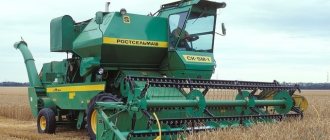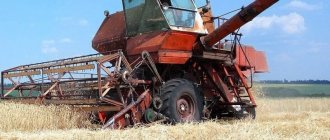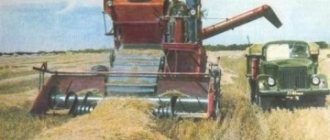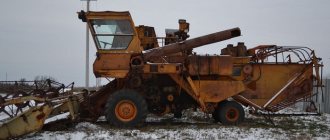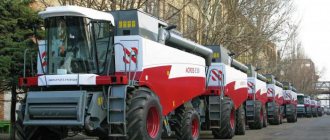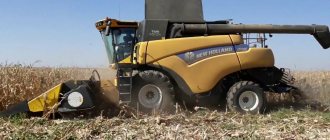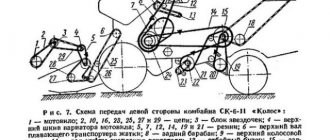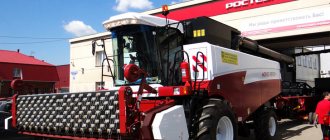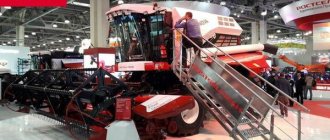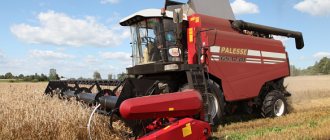Niva SK 5 is a self-propelled grain harvester of medium productivity, produced in the Soviet years by the Rostselmash enterprise. In the 1970-1980s, the model was considered the leader in the combine harvester market and the standard of agricultural engineering in the USSR. Equipment was exported to 50 countries. Later, the model was replaced by more modern combines of the Akros family.
Niva SK 5 is a legend of domestic mechanical engineering. The combine appeared in the mid-1970s and soon became very popular. The release of a deeply modernized variation of the Niva SK 5 continues to this day. Updated versions of the combine can compete with foreign analogues. Niva SK 5 is used in small and medium-sized farms with small cultivation areas, for which the use of high-performance equipment is impractical. In such conditions, the model remains extremely effective, which is why the demand for it continues.
The history of the creation of the Niva SK-5 combine harvester
Famous throughout the country, as well as near and far abroad, its history dates back to the beginning of the 20th century. The Niva SK-5 combine harvesters once came off the assembly line of this very enterprise, and today its modernized descendants are produced there.
The history of this machine, which without exaggeration can be called outstanding, began back in 1958. In June of this year, or rather on the 12th, 27 brand new combines were delivered to the Ministry of Agriculture. These were the first SK-3 self-propelled combines, completely developed by Rostselmash designers.
Combine harvester "Niva" SK-3
This event was of great significance. After all, before this the company produced only trailed combine harvesters. Now the country had the production of cars at a completely different level, modern and productive. In 1961, 100 thousand cars were already produced.
The next stage of development of the model occurred in February 1962. The plant began production of the updated SK-4, this model was 25% more productive than the previous one.
Combine harvester "Niva" SK-4
1st degree diploma in 1963 in Leipzig, in 1964 a medal at an exhibition in Czechoslovakia and the “Silver Cup” - the highest award in Hungary. "Niva SK-4" is the most awarded grain harvesting machine in the world.
Production of the latest model of this series, Niva SK-5, began in 1973. This combine served as the basis for the creation of several highly specialized modifications, for example: a rice harvester for working on slopes up to 30 degrees.
Subsequently, the SK-5 was modernized more than once. It has survived to this day under the name “Niva-effect”.
Video
The history of the model began in 1958. Then the Rostselmash plant presented 27 of the latest SK 3 self-propelled combines, created from scratch (the numbers in the name had the following interpretation: SK - self-propelled combine, 3 - productivity, kg/sec). Previously, the company produced exclusively trailed versions, so the emergence of fundamentally new equipment was of great importance. In the winter of 1962, the SK 4 model with increased productivity was introduced. Another 11 years later, the premiere of the last representative of the family, the Niva SK 5 combine, took place. The equipment appeared as a result of a deep modernization of the previous version. Subsequently, the model was updated several times. Currently, the combine is sold under the name SK 5 Niva-Effect. The equipment now has a cabin with air conditioning, and green is used instead of the traditional red color. The popularity of the car remains high; it can still be found on Russian fields.
News here.
The main field of activity of the combine is the collection and primary processing of grain crops. Maneuverability and compact dimensions allow the equipment to work effectively in difficult terrain and narrow areas. The small turning radius makes the machine ideal for small areas. In cramped conditions, the Niva SK 5 simply has no equal.
Rostselmash also produces a special version designed for wet and weak-bearing soil. The modification is equipped with a half-track. Such changes make it possible to work in rice fields.
Together with special equipment, the combine can harvest corn. Improvements to the header provide the ability to work with soybeans, buckwheat and other cereal crops.
Niva SK 5 remains one of the most reliable and widespread combine harvesters in Russia.
Technical characteristics of the Niva SK-5 combine harvester
The letters SK in the name mean “self-propelled combine”, and the number 5 means its productivity is 5 kg/sec. Let's look at its other characteristics:
- Dimensions length/width/height – 7607/3930/4100 mm;
- Weight – 7400 kg;
- Threshing mechanism – drum, rotation 2900 rpm;
- Hopper volume – 3000 l;
- Unloading the bunker, speed/height – 40 l.sec. / 2.9 m;
- Straw walker – 4 keys;
- Header width – 5 m;
- Knives – 64 pcs;
- The inclined chamber is a conveyor.
Engine of the Niva SK-5 combine harvester
The engine of a combine harvester, like any other equipment, is its heart. It ensures the operation of all machine systems and its movement. The SK-5 was equipped with five different engines: SMD-17K, SMD-18K with a power of 100 hp. and SMD-19K, SMD-20K, SMD-21 with a capacity of 120 horses.
All models are four-stroke, four-cylinder, in-line diesel engines. The last three models presented above are supercharged. The air is forcibly cooled before being supplied to the turbine, which made it possible to efficiently burn a larger amount of fuel in the cylinder, significantly increasing power.
Modern Niva-Effect have a more powerful, 155-horsepower D-260. This engine has lower fuel consumption and increased service life. The engine has a good torque reserve, which ensures reliable operation even under heavy loads.
Variator of combine harvester "Niva" SK-5
The drive on Niva combines is V-belt. This means that torque is transmitted from the engine pulley to the gearbox pulley through a V-belt drive using a variator.
The variator is used to change the gear ratio on a belt drive. This is accomplished by axial displacement of the drive block disk using a hydraulic cylinder. When the disk is moved to the left or right, the width of the stream changes. Accordingly, the belt either moves deeper, reducing the diameter, or is pushed towards the surface of the stream, while its diameter increases.
The variator is controlled from the cab by moving the hydraulic valve spool handle. All the way forward is the maximum speed, backward is the minimum.
Chassis of the Niva SK-5 combine harvester
The chassis of the Niva SK-5 combines includes an axle of driving and steered wheels.
Drive wheel bridge. It includes:
- Transmission
- clutch
- differential
- Gearbox with brake
- two final drives
- wheels.
The clutch is installed on the receiving pulley of the gearbox drive shaft. The driven disk of the clutch is attached to the drive shaft, and the release disk, using 12 springs, presses it against the inner surface of the pulley. When the clutch is disengaged, a special clutch presses on the release levers, thereby releasing the driven disk from the release plate and transmits rotation to the gearbox.
Transmission. Equipped with three shafts and a set of gears. Two movable gears (carriages) are attached to the drive shaft. The first gear includes 1st and reverse gears, and the second gear includes 2nd and 3rd gears. Once the gear is engaged, the locking mechanism locks the gears.
The steering wheel bridge consists of: a rigid beam, steering knuckles, a trapezoid with a hydraulic cylinder, wheels
The axle shafts of the wheels are attached to the ends of the beam using hinges and pins. The hubs are attached to the axle shafts using tapered bearings.
Engine
The latest versions of Niva SK 5 are equipped with 4-stroke in-line diesel units of the MMZ D.260.1 model (manufacturer: Minsk Motor Plant). This engine is ideal for a variety of tasks thanks to its large torque reserve, providing excellent traction when driving on difficult terrain or under full load.
The unit is liquid cooled. Among the advantages of the MMZ D.260.1 engine, moderate fuel consumption and smooth operation should be highlighted. The average fuel consumption for the Niva SK 5 combine harvester with this engine is 25 l/hour. Depending on the nature of the work, the indicator may vary. The unit is located behind the grain bin.
Characteristics of the MMZ D.260.1 motor:
- working volume – 7.12 l;
- rated power – 114 (155) kW (hp);
- maximum torque – 622 Nm;
- rotation speed – 2100 rpm;
- number of cylinders – 6;
- cylinder diameter – 110 mm;
- compression ratio – 16.
Also, the Niva SK 5 model was equipped with the following types of engines:
- diesel units SMD-17K (SMD-18K) with a power of 100 hp;
- diesel engines SMD-19K (SMD-20K) with a power of 120 hp;
- gasoline power plants (the first modifications of the combine).
Header of combine harvester "Niva" SK-5
The purpose of the reaper is to mow and transport the grain mass to the thresher. It is possible to mount a picker on it, the function of which is to pick up beveled stems from the windrows. The working width of the header can be different, and it consists of the following elements:
- Header body with shoes. All working elements of the header are attached to it. The housing is suspended from the inclined chamber; for this, a spherical hinge and special suspensions are used, which are connected by springs that balance the housing. The cutting height is adjustable with shoes and can be 50, 100, 130, and 180 mm. The pressure of the shoes on the soil is regulated using tension springs in the range from 25 to 30 kgf.
- Reel . The task was to bring and support the stems at the time of cutting, then sending them to the auger. Its base is a shaft on which crosspieces are attached, and rakes are attached to them. The latter, in turn, are a tubular shaft with spring-loaded fingers.
- Cutting apparatus . His duty is to cut the stems during harvesting. The apparatus consists of a finger beam with single fingers, and riveted to them with counter-cutting knife plates, friction plates, pressure blades and a drive mechanism. The knife is driven by an articulated telescopic transmission mounted on the header body.
- Auger . Constricts and feeds the flow of stems onto a floating conveyor. It is a cylinder with spiral tapes welded to it, left and right directions, which, when rotated, move the beveled stems to the middle. In the center of the auger there is a finger mechanism that pushes the beveled mass towards the conveyor.
- Floating conveyor . This mechanism accompanies the grain mass from the auger to the combine thresher. The conveyor is located in an inclined housing. Consists of shafts with sprockets, driven and driving. As well as roller-bush chains with steel bars.
- Picker . Picks up the mown mass from the rollers and delivers it to the header platform. To install the pick-up, first remove the reel. Used for separate combining.
Harvest part
The working width of the headers mounted with the Nova-340 combine ranges from four to seven meters, and the feeder chamber of the combine is equipped with a stone catcher and is equipped with a reverse function. The reverse option (for all-wheel drive Nova-340 and Nova-330 - with hydraulic drive) helps out in difficult working conditions. The feeder type is a chain-slat conveyor. There is a spring system for copying the relief, as well as a single hydraulic connector.
The conveyor inclined chamber ensures fast and uniform movement of the grain mass to the threshing drum. To monitor its condition and speed of maintenance, special hatches are provided. A stone catcher located in front of the threshing drum prevents stones from entering the threshing zone.
The relief is copied both in the longitudinal and transverse directions, thanks to balancing springs.
Cabin and steering control of the Niva SK-5 combine harvester
In the old models of the Soviet period, the conditions in the combine cabin were very spartan. Forced ventilation, although present, was not able to save us from the heat, and at that time one could only dream of air conditioning. Although it should be noted that the machine controls were located quite conveniently.
The steering column is directly in front of the operator. In the floor to the right of the column there is a gear shift lever, separate brake pedals, a hay unloading pedal, on the left there is a clutch and a parking brake. To the right of the seat there were levers and switches for controlling various mechanisms and systems of the combine: header, thresher, bunker unloading, etc.
The seat is sprung with adjustments for weight, in the vertical and horizontal plane.
It is worth noting that in modern combine harvester models the cabin is much more comfortable. Upholstery and sound insulation made from modern, high-quality materials. It is possible to install an air conditioner.
Steering.
The steering wheels on the combine are rear. The control system is fully hydraulic, with a hydraulic cylinder in the steering linkage.
Comfortable cabin of the Nova-340 combine
The Nova-340 combine is equipped with a two-seat “Comfort Cab” cabin, the basic equipment of which includes an air conditioning and heating system, a refrigeration compartment for soft drinks, an Adviser II information and voice system and the ability to install the modern agro management platform “Agrotronic”. The cabin is quite wide and comfortable.
The Adviser II information and voice system continuously monitors the threshing processes and the operation of the combine mechanisms, helps control the stability of the technical process and prevent breakdowns of the combine units. It also integrates a loss indicator and a hectare counter.
Real assistance to the operator in his work is provided by the on-board information system with a monitor and voice notification; and all control of the header is done using a joystick - a compact control lever with four buttons.
The Nova-340 combine has this control lever with only four buttons that is very laconic and intuitive. With its help, the functions of the reel are controlled, as well as the raising and lowering of the header. The fourth button stops the header and feed. The lever fits ergonomically in the palm of your hand and provides intuitive and correctly controlled control of the combine.
In general, any operator can immediately find his way around this cabin: the side panel is clearly visible, the location of the keys is well thought out. My only wish is regarding the engine idle/running switch: it could have a clearer designation and a more convenient location. In fact, switching the three stages of a manual transmission turns out to be quite difficult - here, as they say, there is still some work to be done.
Hydraulic system of the Niva SK-5 combine
The combine has two hydraulic systems: main and steering. The hydraulic system serving the working elements of the combine is the main one. It consists of: an NSh-32U hydraulic pump, safety valves, a hydraulic distributor with seven outlets, a double-sided hydraulic cylinder of the chassis variator, two hydraulic cylinders each for lifting the header and reel. Hydraulic control of air purification, opening of the stacker, hopper vibrator.
In the steering hydraulic system: pump NSh-10E, hydraulic distributor, metering pump, power cylinder. The hydraulic tank for both systems is 14 l.
Purpose
The Niva SK 5 series has gained the greatest popularity among small farms with small acreage. The equipment is used in conditions where the use of high-performance machines is impractical. For small plots, the model is irreplaceable; together with the affordable price, this feature ensures a consistently significant demand for this series.
The main area of application of Niva SK 5 is harvesting grain crops. Some modifications of the combine are used for harvesting legumes, rice, soybeans and corn.
Modifications of the Niva SK-5 combine harvester
The SK-5 Niva combine harvester has been modernized several times, let’s look at its main modifications:
- SK-5A - has a high-power engine of 120 horsepower.
- SK-5AM - power was increased to 140 forces, the transmission box was shifted to the left.
- SK-5M-1 - a hydrostatic transmission was installed on this model
Combine harvester "Niva" SK-5M-1
- SKP-5M-1 - could be equipped with a replaceable half-track for work on soils of high humidity.
- SKK-5 is a steep-slope modification, capable of operating on slopes up to 30 degrees.
A unique modification of the harvester for separating pumpkin into pulp and seeds was converted from a production model by a group of enthusiasts.
Transmission and chassis of the Nova-340 combine
The hydrostatic transmission of this agricultural machine provides three forward speeds and one reverse speed. And the maximum transport speed of the combine, which has an operating weight of 11 tons, reaches 30 km/h.
The small dimensions of the combine ensure a modest turning radius: only 7.5 meters. For convenient transportation of the header, a special trailer is provided, thanks to which you can use wide adapters and still maintain full mobility.
Operation of combine harvesters "Niva" SK-5
Over several decades of operation of these machines in our country and the CIS countries, vast operating experience has been accumulated. We simply must apply it to our analysis. Let's see what experienced combine operators write about Niva.
- I have been working at Niva for many years now, and in a year I produce from 300 to 400 hectares per year. Of these, 200 are our own, the rest are from Kolyma. The header is 5 meters long, the engine is not turbocharged. Per day it turns out to be approximately 14-15 hectares per 12-hour shift. Many call such a volume impossible for the Niva, but it is quite possible, although of course not easy. I installed air conditioning and it became much easier. The only significant drawback is the wear of the belts, but replacing them is not difficult.
- My volume is not large, 40 hectares, I harvest it slowly in three days. I bought it 3 years ago, when I was tired of hiring a harvester from outside every year, and this is such a hassle. Even though she works for me 3-4 days a year, my soul is calm, and that’s worth a lot. But I bought the Niva for very little money, which has long since paid off. The equipment is old, and you often have to use your hands, but it does its job without any complaints. In general, if everything is done on time, the car is essentially unkillable.
Now let's look at the advantages and disadvantages:
The advantages include:
- The machine has relatively small dimensions, which allows it to be used on small fields with difficult terrain.
- Good performance and small losses.
- Good grain cleaning.
- Good maneuverability.
- Availability of spare parts, low cost.
Disadvantages:
- Worn drive belts.
A very labor-intensive process of installing the header.
Buying a Niva SK-5 combine harvester: features of choice
The overwhelming majority of these combines are already quite old, and this cannot but affect their condition. Therefore, first of all, we look at the condition of the frame and other structural elements; a rotten car means many problems in the future.
From the mechanisms, inspect: the condition of the drum, by opening the side hatches it is perfectly visible through, you can assess the condition of the thresher whips and concave; inspect the elevators from below, there should be no significant corrosion; assess the condition of the engine and drive belts.
On the secondary market, the price of Niva combines starts at about 100 thousand. Everything lower is, in one way or another, dismantled. The price of a fresh combine is approximately 1.3-1.4 million rubles.
Cost of the Nova-340 combine
The cost of the Rostov Nova-340 combine starts from five million rubles. Moreover, it can be purchased with the help of the state, even without a down payment. The header for this combine will cost another 800 thousand rubles. The secondary market for these combines has not yet formed: very few used ones are offered for sale.
In general, as a representative of the 3rd class, the Nova-340 combine harvester does not have any outstanding characteristics, however, it is at least not inferior to foreign analogues in its class, and costs much less than them. It is important that this compact combine can harvest not only grains, but also all other major agricultural crops.
